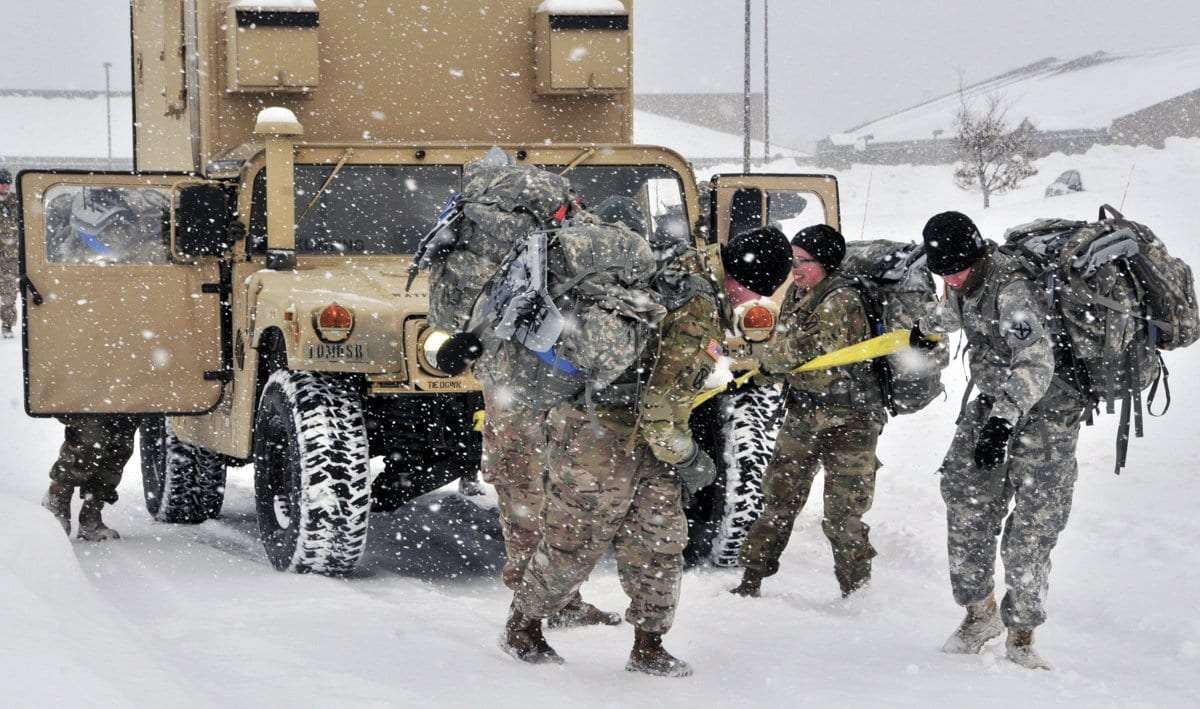
Plans for increased Army training drills in the Adirondacks have some residents concerned
By Gwendolyn Craig
Jerry Delaney Sr. thought his skidder was blowing apart. The heavy-duty transporter for felled trees was shaking. The noise was so loud that he shut it off and jumped.
Then he saw it, a military jet screaming overhead, level with the treetops. Delaney, who was working a logging operation near Franklin Falls, got back on the skidder and continued his work.
Another time, he was buzzed by a couple of military jets while climbing Mount Arab near Tupper Lake. The aircraft had done a tight circle around the mountain, he said, before flying back toward Fort Drum.
“It’s like, damn,” Delaney said and chuckled. “I think it’s a comforting sight.
Other hikers report mistaking military aircraft for thunder.
The mountainous, remote terrain of the Adirondack Park is a paradoxical proving ground, where people seek solace in the great outdoors and soldiers hone their flying skills in preparation for overseas battles or natural disaster responses.
Delaney, executive director of the Adirondack Local Government Review Board, is not the only Adirondack Park resident who has experienced a moment where civilian and Army life collide. And now the U.S. Army proposes air and ground exercises that would create more of them over dozens of days a year.
Some Adirondackers, like Delaney, are comforted by the military presence. Training at home can be the difference between life and death abroad. Others worry about infringements on wildlife, the environment and recreational activities like hiking, snowmobiling and paddling.
The North Country has a considerable military presence, with several Air National Guard bases patrolling the Northeast, military flight zones across the Adirondacks, and the Army’s Fort Drum nearby.
The fort’s plans sparked debate this fall and summer, with visions of both increased air and ground training in the park. The Army installation itself is located in Jefferson County, west of the park, with a campus of more than 100,000 acres.
“While that is pretty big, it’s not big enough to fly for hours,” said John Sheehan, communications director for the Adirondack Council.
Plans for more drills, new locations
The Army has trained in the park before, including on Whiteface Mountain, New York’s fifth-highest and home to a ski resort and a scenic highway. But it is now looking for something more systematic—about six trainings per year, up to 14 days each, with up to seven days for cleanup. At maximum, that’s 126 days.
Last summer the Army released a study, called a programmatic environmental assessment, which determined the training would have no significant impact on the environment. It showed Fort Drum officials are interested in Essex, Hamilton, Herkimer, Jefferson, Lewis, Oneida, Onondaga, Oswego and St. Lawrence counties for additional training. An ad hoc committee narrowed the list of locations. As of December, the Adirondacks were still in the mix. The sites under review included an airport near Saranac Lake, cleared timberlands, and state lands outside of the Adirondack Park, documents show.
The Army’s assessment was a jumping-off point to work with communities on Fort Drum’s training needs, fort Public Affairs Director Julie Halpin said.

“In the past, major training events in these counties were coordinated singularly—‘reinventing the wheel’ every time,” Halpin said.
Questions raised
At first, environmental groups worried the Army would look at training on state forest preserve and wilderness lands. Some local officials, like Delaney, believe protected lands in the Adirondack Park could be the perfect place for Army training. Others disagree.
Most groups are calling for the Army to conduct an environmental impact statement, a more rigorous federal analysis of the impacts of military training.
Fort Drum’s training proposal is specifically for soldiers in its 10th Mountain Division’s Aviation Brigade and Sustainment Brigade.
When asked why Fort Drum was looking at increasing its training for soldiers, Halpin said, “There is an old Army adage that we sweat in training so we don’t bleed in combat.”
Adirondack policy report
Stay up on policy news through Gwen’s weekly Adirondack Report newsletter
The Army’s environmental assessment also states that warfare has changed, particularly in the air. New strategies and weapons are shifting flight trainings to lower altitudes. It’s also beneficial to train in the mountains, Halpin said, to help soldiers prepare for flying in similar terrain in Afghanistan or northern parts of Iraq. Even when assisting with emergency events in the United States, Fort Drum flyers may need to fly in mountainous regions.
Large-scale, realistic training events are important for increasing soldiers’ survivability, the document adds.

The Army is looking for places that avoid populated areas, are 10 acres or larger, have road access and have few trees or tall structures.
One proposed operation involves 400 soldiers setting up camp and sleeping in tents. Eighteen helicopters would be stationed nearby, along with 60 military vehicles. Flares, colored smoke canisters and blanks would mimic live-fire. Foxholes could be dug. Kitchens and fueling stations could be set up.
The proposed trainings would not use live ammunition.
Next steps
In November, the Army organized an ad hoc committee of state agencies, the New York Air National Guard and environmental organizations. The group was reviewing six specific sites the Army is interested in for training: the privately owned North Lake Tract Easement in Herkimer County; private timberlands on Sevey’s Easement in St. Lawrence County; Cobb Creek State Forest in Lewis County; St. Lawrence County land in the Town of Pierrepont; Sand Flats State Forest in Lewis county; and Adirondack Regional Airport near Saranac Lake.
Halpin said these places “are starting points for discussion.”
David Gibson, managing partner of Adirondack Wild: Friends of the Forest Preserve, was glad the Army organized a committee. He is on it.
“That’s a very positive thing that they’ve done,” Gibson said, “the willingness to slow down and make sure that stakeholders’ inputs are more thoroughly considered before taking their next steps.”
What concerned some state representatives and advocates like Gibson about Fort Drum’s environmental study was that it completely left out the Adirondack Park Agency.
In leaving the agency out, the Army also did not consider any land classifications the APA and its regulations spell out, nor did it mention state constitutional protections afforded to lands deemed “forever wild.” The clause in the state Constitution prevents any lease, sale or development on the forest preserve. The assessment did not mention any specific state management plans or easements. It did not mention that the approximately 2.6 million acres of forest preserve are listed under the National Register of Historic Places. The federal designation is under the National Park Service and the National Historic Preservation Act, and helps protect historic and archaeological resources.
“That was kind of a scary moment,” Gibson said.
A spokesperson for the DEC said the agency suggested the Army clarify the different land classifications of forest preserve and state lands.
Following eight requests for comment and requests for an interview with APA Director Terry Martino over three weeks, an APA spokesperson told the Adirondack Explorer that Martino was not available.
“At this point we are working with the military and are very confident that we will be able to find a solution that meets their important training needs and does not have an undue impact on the natural resources of the Adirondack Park,” the spokesperson wrote. The Army has since included the APA in discussions, and the agency is part of the Army’s ad hoc committee.
In a letter from the agency’s deputy director of planning to Fort Drum, which the Explorer obtained through a Freedom of Information Law request, APA questioned the Army’s assessment of the plan’s impacts.
“The APA recognizes and supports the U.S. Army’s critical mission to provide effective training,” Deputy Director Richard Weber wrote. “The scope and detail of the analysis at the programmatic level however does not appear to be sufficient to support a finding of no significant impact given the complexity and sensitivity of the Action Area and the Adirondack Park in particular.”
Weber’s letter went on about the APA’s jurisdiction and how he disagreed with the Army’s finding that up to 126 days of training per year would have no significant impact on the environment.
“A program of repeated training of this nature, year after year with coordinated air and motor vehicle support and with the temporary development of encampments ranging in size between 5 and 10 acres has the potential to create longer term impacts to overall management of State lands in the Park,” Weber continued.
Weber called it “paramount” to consider “preservation of the natural resources of state lands,” and also referenced the park’s role in outdoor recreation.
Addressing other concerns
While the Army’s assessment said it would avoid public lands during hunting, fishing and boating seasons, other outdoor recreational activities were left out.
Dominic Jacangelo, executive director of the New York State Snowmobile Association, said there are more than 3,000 miles of snowmobile trails in the nine-county action area that the Army identified in its assessment, and trails in some of the six locations the Army has singled out. The snowmobile association is not part of the ad hoc committee.
“Unless they intend to not have any operations in the winter, there’s a potential for a big impact on what we do and the communities that we contribute to during that time,” Jacangelo said.
The Tug Hill Commission, which is part of the ad hoc committee, will consider snowmobile and ATV trails, too. Katie Malinowski, executive director, said the agency didn’t have any specific concerns on the Army’s proposal, but will look at the region more closely for any overlapping activities. The commission is also looking at whether any wind or solar project proposals could be affected.
“Overall, Tug Hill communities are very supportive of Fort Drum,” Malinowski said. “I think people in the North Country are pretty patriotic, and they’re glad to be able to do their part in supporting the military and the Army.”
The Adirondack Mountain Club, in its written comments to the Army, also drew attention to the “hiking, running, camping, swimming, paddling, birdwatching, snowshoeing, climbing, skiing, equestrian use, and biking” that occur in the region.
“These important recreational activities must be considered and public lands must be avoided to protect the quality of these recreational experiences,” ADK’s letter read.
Cathy Pedler, ADK’s director of advocacy and part of the ad hoc committee, said in a statement to the Explorer that the ad hoc committee also needs to review potential flight paths. The Army has not yet provided those, she said.
Pedler learned the Army plans to use mostly helicopters for its additional low-altitude air trainings, including models like AH-64 Apaches, CH-47 Chinooks, and UH-60 Black Hawks. The Army will also use unmanned aircraft.
“These types of flights certainly have the potential to impact wilderness and wildlife, as well as the quality of recreational experiences,” Pedler said.
Sheehan and Gibson, both ad hoc committee members, were pleased to see that the Army is trying to avoid conflicts with forest preserve, wildlife and people.
They are troubled, however, by the Army’s inclusion of Adirondack Regional Airport in Lake Clear. In October, the DEC classified the airport as a hazardous waste site due to elevated levels of PFAS, a cancer-causing substance, in the groundwater.
“This may be a real test of their logistical capacities, having to provide potable water,” Sheehan said.
Lake Clear is also an important spot for the iconic Adirondack bird, the common loon. The National Audubon Society lists Lake Clear and surrounding lakes as an important bird zone called the Adirondack Loon Complex.
Sevey’s Easement also raised some red flags for environmental groups. The area is important habitat for the spruce grouse, listed by the state as endangered. In fact, the state passed a constitutional amendment in 2009 to route power lines through forest preserve lands to avoid disturbing these chicken-like fowl.
Support this work
A donation today will help pay for the Adirondack Explorer‘s reliable coverage of the issues important to the Adirondack Park.
Others think the Adirondacks, and even forest preserve, could be prime training grounds for the Army.
Essex County was among areas initially listed for consideration. Though none of the six sites currently discussed are in the county, Shaun Gillilland, chairman of the Essex County Board of Supervisors, said he would welcome training in his area.
Gillilland is a U.S. Navy veteran. He, too, used to train in environmentally sensitive areas, and the military, he said, took extra precautions when it came to protecting natural resources.
The proposed North Country training should have little effect on wildlands, Gillilland said.
“That’s the Army going out and camping,” he said. “What’s the difference between that and someone getting stuff from REI (outdoors store) and camping?”
Delaney, too, said the park and even forest preserve could offer a solution for the Army.
“We wouldn’t have this great land without them,” he said.
Environmental groups are getting more calls than ever about military flights and surprise sonic booms. While those have generally been traced back to Air National Guard bases in the Northeast, and not to Fort Drum, they have perhaps made the general public leery.
One sonic boom reportedly threw a man off his horse while riding in the western Adirondacks last summer. Adirondack Mountain Club’s mountaintop educators, the Summit Stewards, have reported hearing military aircraft while on Wright, Algonquin and Marcy—some of the Adirondack’s High Peaks.
“Summit Stewards report that they and other hikers have confused the noise of jets and helicopters with thunder,” Pedler said. Hikers are advised to find safety below summit and paddlers are advised to head for shore during storms. Pedler worries people could let down their guard if they believe noises are coming from fighter jets instead of thunder.
Gillilland and Delaney think most residents know by now of the military presence here.
“Knowing the residents of the Adirondack Park, seeing Army helicopters flying around would be met more with pride than fear or trepidation,” Gillilland said.
Some groups think Fort Drum should allow more public comment and meetings on its proposal. The ad hoc committee meetings are closed to the public, and are not subject to the state’s Open Meetings Law.
Pedler said she expects there to be at least a virtual public information session at some point.
Subscribe to the magazine
This article is in the Jan/Feb 2021 issue of Adirondack Explorer.
Sign up to get it delivered 7 times a year to your mailbox!
"explorer" - Google News
January 10, 2021 at 07:01PM
https://ift.tt/2MSpu4z
Operation Adirondack Thunder - Adirondack Explorer
"explorer" - Google News
https://ift.tt/2zIjLrm
Bagikan Berita Ini















0 Response to "Operation Adirondack Thunder - Adirondack Explorer"
Post a Comment